Comparison of Satellite Driven Surface Energy Balance Models in Estimating Crop Evapotranspiration in Semi-Arid to Arid Inter-Mountain Region
Abstract
:1. Introduction
2. Materials and Methods
2.1. Study Area, Climate and Satellite Dataset, and Image Processing
2.2. Energy Balance Models (SEB)
2.2.1. METRIC Model and SEBAL Model
2.2.2. SEBS Model
2.2.3. S-SEBI Model
2.3. Models Validation
3. Results
3.1. Comparison between SEB-Estimated and BREBS-Measured Instantaneous Fluxes
3.2. Comparison of Estimated and Measured Monthly Crop Evapotranspiration (ETc)
3.3. Intercomparison of SEB Model Estimated Daily Evapotranspiration (ET24)
3.4. Mapping Spatial Variation of SEB Model-Estimated Seasonal Evapotranspiration (ETc)
4. Discussion
4.1. SEB Models and Their Strengths and Limitations
4.2. SEB Models Implication
5. Summary and Conclusions
Supplementary Materials
Author Contributions
Funding
Institutional Review Board Statement
Informed Consent Statement
Data Availability Statement
Conflicts of Interest
References
- FAO. The Global Framework on Water Scarcity in Agriculture; FAO: Rome, Italy, 2018; Available online: http://www.fao.org/land-water/overview/wasag/en/ (accessed on 17 December 2020).
- Trenberth, K.E.; Smith, L.; Qian, T.; Dai, A.; Fasullo, J. Estimates of the Global Water Budget and Its Annual Cycle Using Observational and Model Data. J. Hydrometeorol. 2007, 8, 758–769. [Google Scholar] [CrossRef]
- Allen, R.G.; Pereira, L.S.; Raes, D.; Smith, M. FAO Irrigation and Drainage Paper No. 56: ETc; FAO: Rome, Italy, 1998. [Google Scholar]
- Yimam, Y.T.; Ochsner, T.E.; Kakani, V.G. Evapotranspiration partitioning and water use efficiency of switchgrass and biomass sorghum managed for biofuel. Agric. Water Manag. 2015, 155, 40–47. [Google Scholar] [CrossRef] [Green Version]
- Yan, H.; Wang, S.Q.; Billesbach, D.; Oechel, W.; Bohrer, G.; Meyers, T.; Martin, T.A.; Matamala, R.; Phillips, R.P.; Rahman, F.; et al. Improved global simulations of gross primary product based on a new definition of water stress factor and a separate treatment of C3 and C4 plants. Ecol. Model. 2015, 297, 42–59. [Google Scholar] [CrossRef]
- Evett, S.R.; Schwartz, R.C.; Howell, T.A.; Baumhardt, R.L.; Copeland, K.S. Can weighing lysimeter ET represent surrounding field ET well enough to test flux station measurements of daily and sub-daily ET? Adv. Water Resour. 2012, 50, 79–90. [Google Scholar] [CrossRef]
- Moorhead, J.E.; Marek, G.W.; Gowda, P.H.; Lin, X.; Colaizzi, P.D.; Evett, S.R.; Kutikoff, S. Evaluation of Evapotranspiration from Eddy Covariance Using Large Weighing Lysimeters. Agronomy 2019, 9, 99. [Google Scholar] [CrossRef] [Green Version]
- Irmak, S. Nebraska Water and Energy Flux Measurement, Modeling, and Research Network (NEBFLUX). Trans. ASABE 2010, 53, 1097–1115. [Google Scholar] [CrossRef]
- Smith, D.M.; Allen, S.J. Measurement of sap flow in plant stems. J. Exp. Bot. 1996, 47, 1833–1844. [Google Scholar] [CrossRef] [Green Version]
- Allen, R.G.; Tasumi, M.; Morse, A.T.; Trezza, R.; Wright, J.L.; Bastiaanssen, W.; Kramber, W.; Lorite, I.; Robison, C.W. Satellite-based energy balance for mapping evapotranspiration with internalized calibration (METRIC)-Applications. J. Irrig. Drain. Eng. 2007, 133, 395–406. [Google Scholar] [CrossRef]
- Gibson, J.J. Short-term evaporation and water budget comparisons in shallow Arctic lakes using non-steady isotope mass balance. J. Hydrol. 2002, 264, 242–261. [Google Scholar] [CrossRef]
- Foken, T. Micrometeorology. Springer: Berlin/Heidelberg, Germany, 2008. [Google Scholar]
- Allen, R.G.; Tasumi, M.; Trezza, R. Satellite-based energy balance for mapping evapotranspiration with internalized calibration (METRIC) -Model. J. Irrig. Drain. Eng. 2007, 133, 380–394. [Google Scholar] [CrossRef]
- Bastiaanssen, W.G.M.; Menenti, M.; Feddes, R.A.; Holtslag, A.A.M. A remote sensing Surface Energy Balance algorithm for land (SEBAL):1. Formulation. J. Hydrol. 1998, 212–213, 198–212. [Google Scholar] [CrossRef]
- Bastiaanssen, W.G.M.; Pelgrum, H.; Wang, J.; Ma, Y.; Moreno, J.; Roerink, G.J.; van der Wal, T. The Surface Energy Balance algorithm for land (SEBAL): 2. Validation. J. Hydrol. 1998, 212–213, 213–229. [Google Scholar] [CrossRef]
- Su, Z. The Surface Energy Balance system (SEBS) for estimation of turbulent heat fluxes. Hydrol. Earth Syst. Sci. 2002, 6, 85–99. [Google Scholar] [CrossRef]
- Sharma, V.; Irmak, S.; Kilic, A.; Mutiibwa, D. Application of Remote Sensing for Quantifying and Mapping Surface Energy Fluxes in South Central Nebraska: Analyses with Respect to Field Measurements. Trans. ASABE 2015, 58, 1265–1285. [Google Scholar] [CrossRef]
- Senay, G.B.; Bohms, S.; Singh, R.K.; Gowda, P.H.; Velpuri, N.M.; Alemu, H.; Verdin, J.P. Operational evapotranspiration mapping using remote sensing and weather datasets—A new parameterization for the SSEB approach. J. Am. Water Resour. Assoc. 2013, 49, 577–591. [Google Scholar] [CrossRef] [Green Version]
- Roerink, G.J.; Su, Z.; Menenti, M. S-SEBI: A simple remote sensing algorithm to estimate the Surface Energy Balance. Phys. Chem. Earth Part B 2000, 25, 147–157. [Google Scholar] [CrossRef]
- Meneti, M.; Choudhary, B.J. Parameterization of land surface evapotranspiration using a location dependent potential evapotranspiration and surface temperature range. Exch. Process. Land Surf. 1993, 212, 561–568. [Google Scholar]
- Mecikalski, J.R.; Diak, G.R.; Anderson, M.C.; Norman, J.M. Estimating Fluxes on Continental Scales Using Remotely Sensed Data in an Atmospheric–Land Exchange Model. J. App. Meteorol. 1999, 38, 1352–1369. [Google Scholar] [CrossRef]
- Anderson, M.; Norman, J.; Diak, G.; Kustas, W.; Mecikalski, J.R. A two-source time integrated model for estimating surface fluxes using thermal infrared remote sensing. Remote Sens. Environ. 1997, 60, 195–216. [Google Scholar] [CrossRef]
- Norman, J.M.; Kustas, W.P.; Humes, K.S. Source approach for estimating soil and vegetation energy fluxes in observations of directional radiometric surface temperature. Agric. For. Meteorol. 1995, 77, 263–293. [Google Scholar] [CrossRef]
- Merlin, O.; Duchemin, B.; Hagolle, O.; Jacob, F.; Coudert, B.; Chehbouni, G.; Dedieu, G.; Garatuza, J.; Kerr, Y. Disaggregation of MODIS Surface Temperature over an Agricultural Area Using Time Series of Formosat-2 Images. Remote Sens. Environ. 2010, 114, 2500−2512. [Google Scholar] [CrossRef] [Green Version]
- Acharya, B.; Sharma, V.; Heitholt, J.; Tekiela, D.; Nippgen, F. Quantification and Mapping of Satellite Driven Surface Energy Balance Fluxes in Semi-Arid to Arid Inter-Mountain Region. Remote Sens. 2020, 12, 4019. [Google Scholar] [CrossRef]
- Singh, R.K.; Senay, G.B. Comparison of Four Different Energy Balance Models for Estimating Evapotranspiration in the Midwestern United States. Water 2016, 8, 9. [Google Scholar] [CrossRef] [Green Version]
- Bastiaanssen, W.; Thoreson, B.; Clark, B.; Davids, G. Discussion of application of SEBAL model for mapping evapotranspiration and estimating surface energy fluxes in South-Central Nebraska by Ramesh K Singh, Ayse Irmak, Suat Irmak and Derrel L Martin. J. Irrig. Drain. Eng. 2010, 136, 282–283. [Google Scholar] [CrossRef]
- Sobrino, J.; Gomez, M.; Jimenez-Munoz, J.; Olioso, A.; Chehbouni, G. A simple algorithm to estimate evapotranspiration from DAIS data: Application to the DAISEX campaigns. J. Hydrol. 2005, 315, 117–125. [Google Scholar] [CrossRef] [Green Version]
- Bhattarai, N.; Shaw, S.B.; Quackenbush, L.J.; Lm, J.; Niraula, R. Evaluation of five remote sensing based single-source Surface Energy Balance models for estimating daily evapotranspiration in a humid subtropical climate. Int. J. Appl. Earth Obs. Geoinf. 2016, 49, 75–86. [Google Scholar] [CrossRef]
- Wagle, P.; Bhattarai, N.; Gowda, P.H.; Kakani, V.G. Performance of five Surface Energy Balance models for estimating daily evapotranspiration in high biomass sorghum. ISPRS J. Photogramm. Remote Sens. 2017, 128, 192–203. [Google Scholar] [CrossRef] [Green Version]
- Losgedaragh, S.Z.; Rahimzadegan, M. Evaluation of SEBS, SEBAL, and METRIC models in estimation of the evaporation from the freshwater lakes (Case study: Amirkabir dam, Iran). J. Hydrol. 2018, 561, 523–531. [Google Scholar] [CrossRef]
- Chirouze, J.; Boulet, G.; Jarlan, L.; Fieuzal, R.; Rodriguez, J.C.; Ezzahar, J.; Er-Raki, S.; Bigeard, G.; Merlin, O.; Garatuza-Payan, J.; et al. Intercomparison of four remote-sensing-based energy balance methods to retrieve surface evapotranspiration and water stress of irrigated fields in semi-arid climate. Hydrol. Earth Syst. Sci. 2014, 18, 1165–1188. [Google Scholar] [CrossRef] [Green Version]
- Liaqat, U.W.; Choi, M. Surface energy fluxes in the Northeast Asia ecosystem: SEBS and METRIC models using Landsat satellite images. Agric. For. Meteorol. 2015, 214, 60–79. [Google Scholar] [CrossRef]
- French, A.N.; Hunsaker, D.J.; Thorp, K.R. Remote sensing of evapotranspiration over cotton using the TSEB and METRIC energy balance models. Remote Sens. Environ. 2015, 158, 281–294. [Google Scholar] [CrossRef]
- Lu, J.; Sun, G.; McNulty, S.G.; Amatya, D.M. A comparison of six potential evapotranspiration methods for regional use in the southeastern United States. J. Am. Water Resour. Assoc. 2005, 41, 621–633. [Google Scholar] [CrossRef]
- Allen, R.G.; Irmak, A.; Trezza, R.; Hendrickx, J.; Bastiaanssen, W. Satellite Based ET Estimation in Agriculture using SEBAL and METRIC. J. Hydrol. Process. 2011, 25, 4011–4027. [Google Scholar] [CrossRef]
- Tasumi, M.; Moriyama, M.; Shinohara, Y. Application of GCOM-C SGLI for agricultural water management via field evapotranspiration. Paddy Water Environ. 2019, 17, 75–82. [Google Scholar] [CrossRef]
- Orth, R.; Staudinger, M.; Seneviratne, S.I.; Seibert, J.; Zappa, M. Does model performance improve with complexity? A case study with three hydrological models. J. Hydrol. 2015, 523, 147–159. [Google Scholar] [CrossRef] [Green Version]
- PRISM Climate Group. Oregon State University. 2015. Available online: http://prism.oregonstate.edu (accessed on 25 July 2020).
- Sharma, V.; Nicholson, C.; Bergantino, A.; Irmak, S.; Peck, D. Temporal Trend Analysis of Meteorological Variables and Reference Evapotranspiration in the Inter-mountain Region of Wyoming. Water 2020, 12, 2159. [Google Scholar] [CrossRef]
- Rai, A.; Sharma, V.; Heitholt, J. Dry Bean [Phaseolus vulgaris L.] Growth and Yield Response to Variable Irrigation in the Arid to Semi-Arid Climate. Sustainability 2020, 12, 3851. [Google Scholar] [CrossRef]
- Sharma, V.; Nicholson, C.; Bergantino, T.; Cowley, J.; Hess, B.; Tanaka, J. Wyoming Agricultural Climate Network (WACNet). In Agricultural Experiment Station 2018 Field Days Bulletin; University of Wyoming: Laramie, WY, USA, 2018; pp. 52–53. [Google Scholar]
- High Plains Regional Climate Center. Data Access. 2020. Available online: https://hprcc.unl.edu/awdn/ (accessed on 2 April 2021).
- Cook, D.R.; Sullivan, R.C. Energy Balance Bowen Ratio (EBBR) Instrument Handbook; Argonne National Laboratory: Argonne, IL, USA, 2019.
- Huete, A.R.; Jackson, R.D.; Post, D.F. Spectral response of a plant canopy with different soil backgrounds. Remote Sens. Environ. 1985, 17, 37–53. [Google Scholar] [CrossRef]
- Huete, A.R. A Soil-Adjusted Vegetation Index (SAVI). Remote Sens. Environ. 1988, 25, 295–309. [Google Scholar] [CrossRef]
- Starks, P.J.; Norman, J.M.; Blad, B.L.; Walter-Shea, E.A.; Walthall, C.L. Estimation of shortwave hemispherical reflectance (albedo) from bidirectionally reflecteOdahod radiance data. Remote Sens. Environ. 1991, 38, 123–134. [Google Scholar] [CrossRef]
- Tasumi, M.; Allen, R.G.; Trezza, R. At-surface albedo from Landsat and MODIS satellites for use in energy balance studies of evapotranspiration, J. Hydrol. Eng. 2008, 13, 51–63. [Google Scholar] [CrossRef]
- Olmedo, G.F.; Ortega-Farías, S.; Fuente-Sáiz, D.; Fonseca- Luego, D.; Fuentes-Peñailillo, F. Water: Tools and Functions to Estimate Actual Evapotranspiration Using Land Surface Energy Balance Models in R. R J. 2016, 8, 352–369. [Google Scholar] [CrossRef] [Green Version]
- Morse, A.; Tasumi, M.; Allen, R.G.; Kramber, W.J. Application of the SEBAL Methodology for Estimating Consumptive Use of Water and Streamflow Depletion in the Bear River Basin of Idaho through Remote Sensing; Final Report, Phase I, Submitted to The Raytheon Systems Company, Earth Observation System Data and Information System Project; Idaho Department of Water Resources and University of Idaho: Moscow, ID, USA, 2000. [Google Scholar]
- Duffie, J.A.; Beckman, W.A. Solar Engineering of Thermal Processes, 2nd ed.; John Wiley and Sons: New York, NY, USA, 1991. [Google Scholar]
- Tasumi, M. Progress in Operational Estimation of Regional Evapotranspiration Using Satellite Imagery. Ph.D. Thesis, University of Idaho, Moscow, ID, USA, 2003. [Google Scholar]
- ASCE-EWRI. The ASCE standardized reference evapotranspiration equation. In ASCE-EWRI Standardization of Reference Evapotranspiration Task Committee Report; ASCE Bookstore: Reston, VA, USA, 2005. [Google Scholar]
- Romero, M.G. Daily Evapotranspiration Estimation by Means of Evaporative Fraction and Reference ET Fraction. Ph.D. Thesis, Utah State University, Logan, UT, USA, 2004. [Google Scholar]
- Shuttleworth, W.J.; Gurney, R.J.; Hsu, A.Y.; Ormsby, J.P. FIFE: The variation in energy partition at surface flux sites. IAHS Publ. 1989, 186, 67–74. [Google Scholar]
- Paulson, C.A. The mathematical representation of wind speed and temperature profiles in the unstable atmospheric surface layer. J. Appl. Meteorol. 1970, 9, 857–861. [Google Scholar] [CrossRef]
- Webb, E.K. Profile relationships: The log-linear range, and extension to strong stability. Qtly. J. Royal Meteorol. Soc. 1970, 96, 67–90. [Google Scholar] [CrossRef]
- Brutsaert, W. Evaporation into the Atmosphere: Theory, History, and Applications; Springer: Dordrecht, The Netherlands, 1982. [Google Scholar] [CrossRef]
- Monteith, J.L. Evaporation and surface temperature. Qtly. J. Royal Meteorol. Soc. 1981, 107, 1–27. [Google Scholar] [CrossRef]
- Guillevic, P.C.; Privette, J.L.; Coudert, B.; Palecki, M.A.; Demarty, J.; Ottlé, C.; Augustine, J.A. Land surface temperature product validation using NOAA’s surface climate observation networks: Scaling methodology for the Visible Infrared Imager Radiometer Suite (VIIRS). Remote Sens. Environ. 2012, 124, 282–298. [Google Scholar] [CrossRef] [Green Version]
- Horton, R.; Bristow, K.L.; Kluitenberg, G.; Sauer, T.J. Crop residue effects on surface radiation and energy balance: Review. Theor. Appl. Climatol. 1996, 54, 27–37. [Google Scholar] [CrossRef] [Green Version]
- Byun, K.; Liaqat, U.W.; Choi, M. Dual-model approaches for evapotranspiration analyses over homo- and heterogeneous land surface conditions, Agric. For. Meteorol. 2014, 197, 169–187. [Google Scholar] [CrossRef]
- Liaqat, U.W.; Choi, M.; Awan, U.K. Spatio-temporal distribution of actual evapotranspiration in the Indus Basin Irrigation System. Hydrol. Process. 2014, 29, 2613–2627. [Google Scholar] [CrossRef]
- Gokmen, M.; Vekerdy, Z.; Verhoef, A.; Verhoef, W.; Batelaan, O.; van der Tol, C. Integration of soil moisture in SEBS for improving evapotranspiration estimation under water stress conditions. Remote Sens. Environ. 2012, 121, 261–274. [Google Scholar] [CrossRef]
- Long, D.; Singh, V.P.; Li, Z.-L. How sensitive is SEBAL to changes in input variables, domain size and satellite sensor? J. Geophys. Res. Atmos. 2011, 116, D21107. [Google Scholar] [CrossRef]
- Barr, A.G.; King, K.M.; Gillespie, T.J.; Hartog, G.D.; Neumann, H.H. A comparison of bowen ratio and eddy correlation sensible and latent heat flux measurements above deciduous forest. Bound. Layer Meteorol. 1994, 71, 21–41. [Google Scholar] [CrossRef]
- McBean, G.A. Role of Active-Passive Scalar Relationships in Evaporation from Vegetated Surfaces. In Advances in Theoretical Hydrology; O’Kane, J.R., Ed.; Elsevier Science: Amsterdam, The Netherlands, 1992; pp. 47–58. [Google Scholar]
- Allen, R.G.; Tasumi, M.; Morse, A.T.; Trezza, R. A Landsat-based energy balance and evapotranspiration model in Western US water rights regulation and planning. Irrig. Drain. Syst. 2005, 19, 251–268. [Google Scholar] [CrossRef]
- Hansen, K.; Nicholson, C.M.; Paige, G. Wyoming’s Water: Resources & Management; University of Wyoming Extension: Laramie, WY, USA, 2015. [Google Scholar]
- Uniyal, B.; Dietrich, J.; Vasilakos, C.; Tzoraki, O. Evaluation of SWAT simulated soil moisture at catchment scale by field measurements and Landsat derived indices. Agric. Water Manag. 2017, 193, 55–70. [Google Scholar] [CrossRef]
- Parajuli, P.B.; Jayakody, P.; Ouyang, Y. Evaluation of Using Remote Sensing Evapotranspiration Data in SWAT. Water Resour. Manag. 2018, 32, 985–996. [Google Scholar] [CrossRef]
- Jiang, L.; Wu, H.; Tao, J.; Kimball, J.S.; Alfieri, L.; Chen, X. Satellite-based evapotranspiration in hydrological model calibration. Remote Sens. 2020, 12, 428. [Google Scholar] [CrossRef] [Green Version]

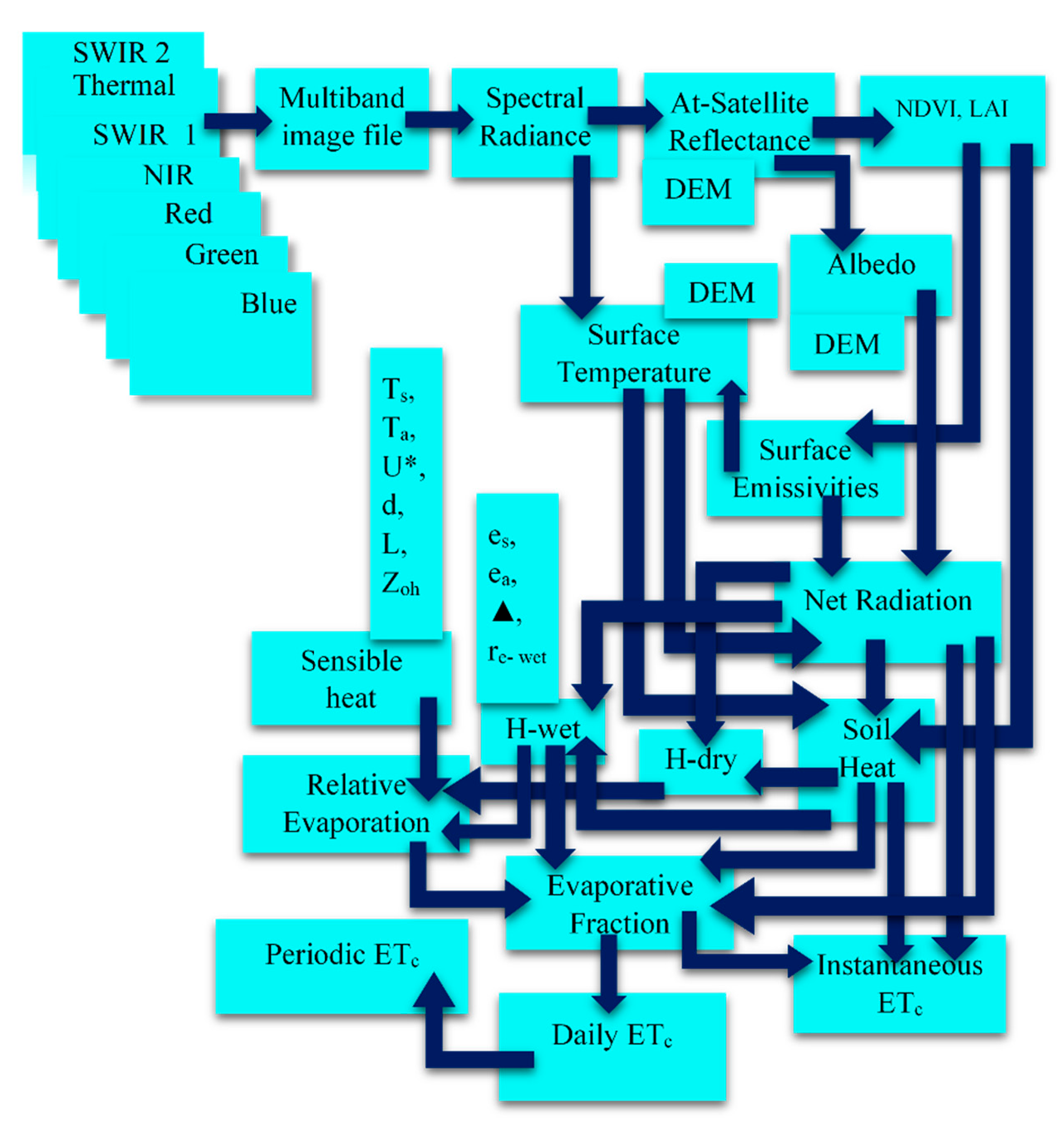
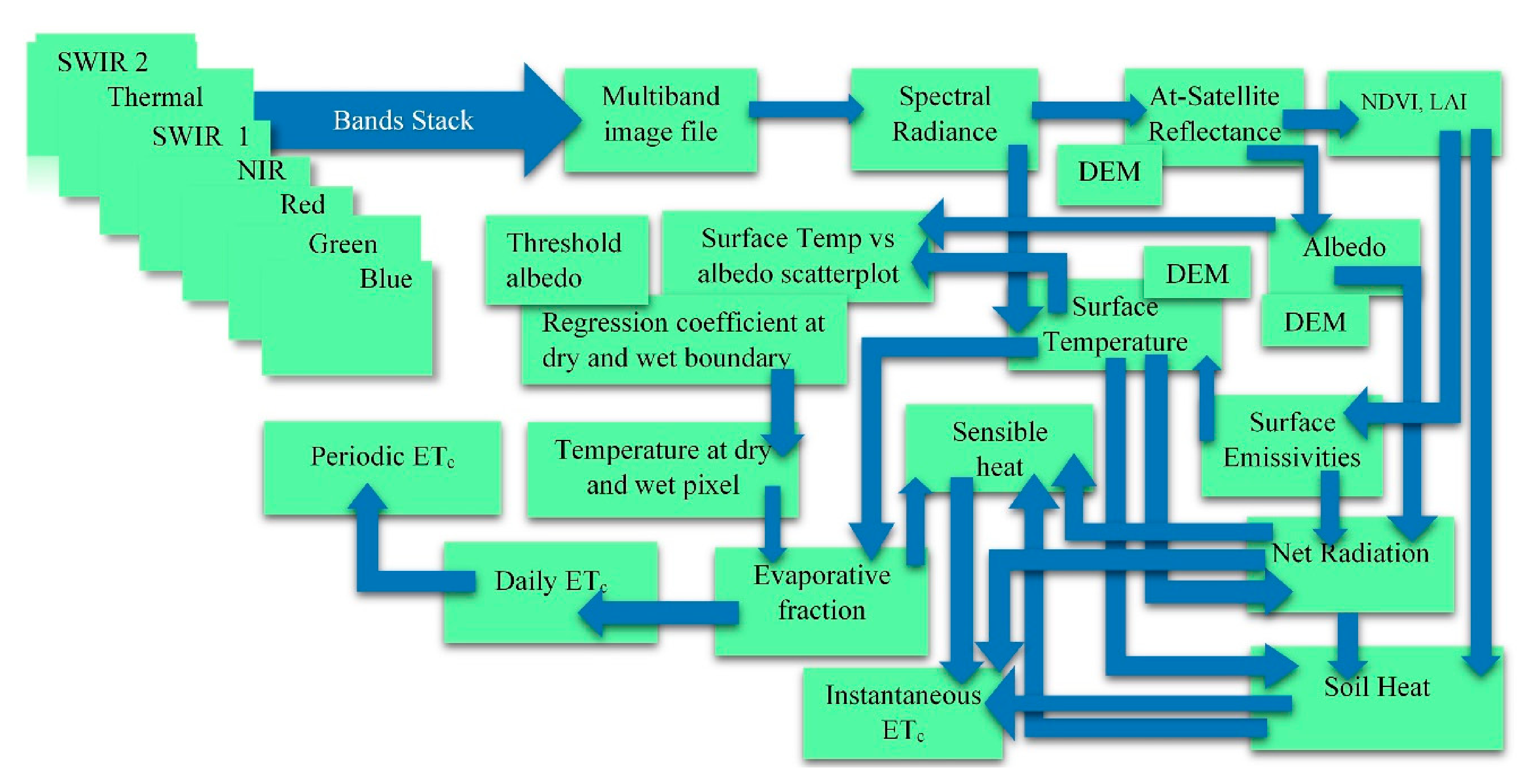

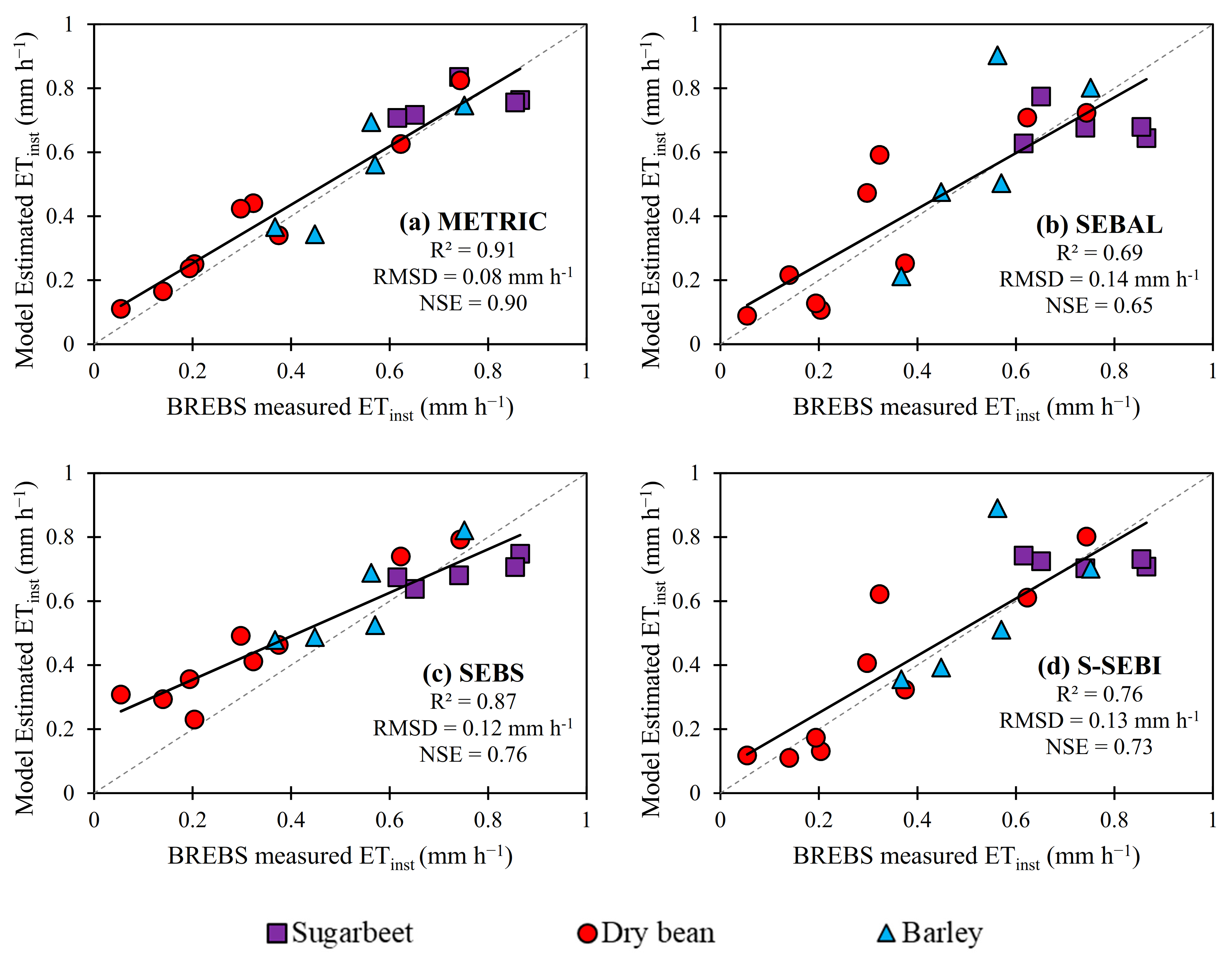


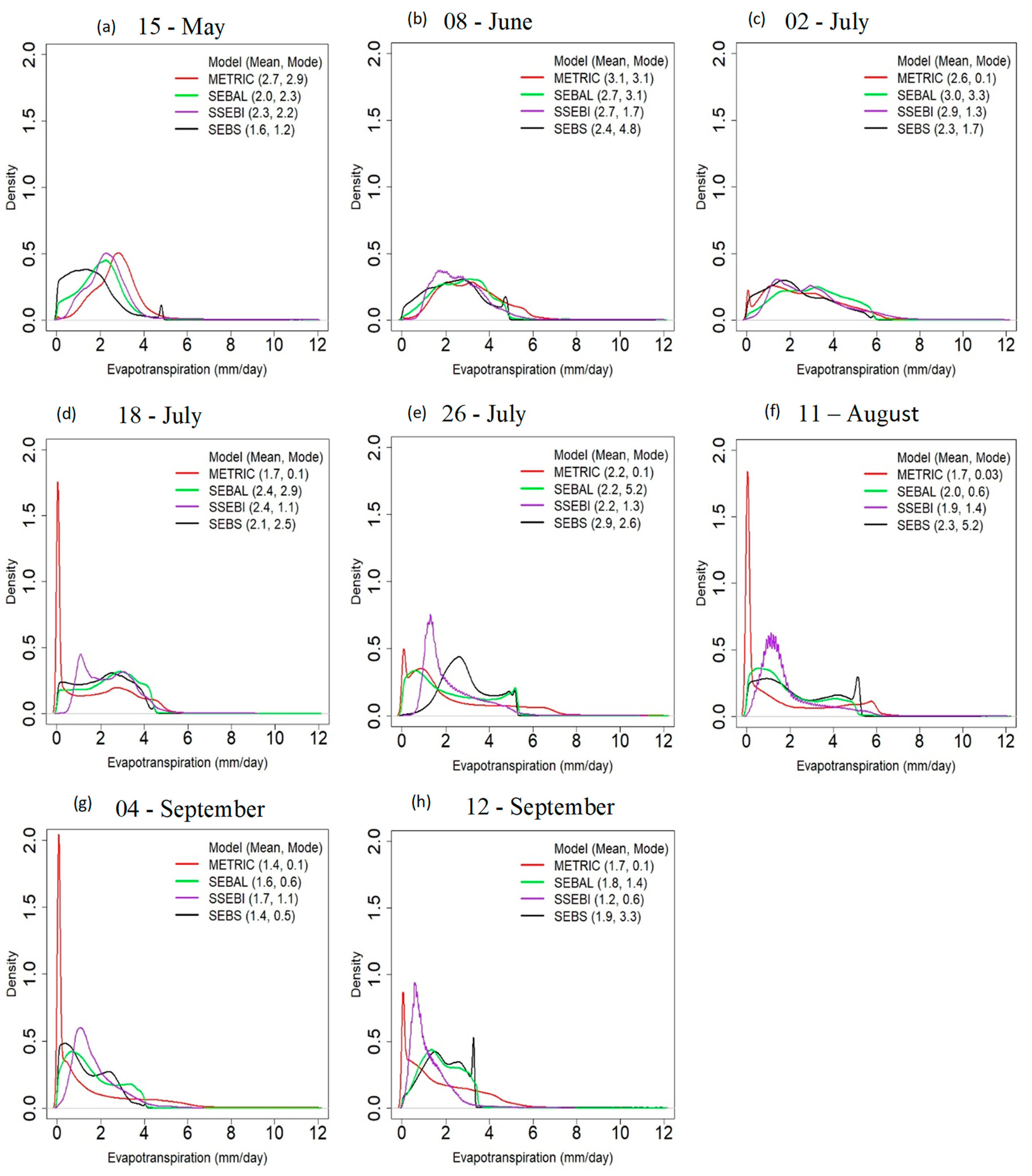
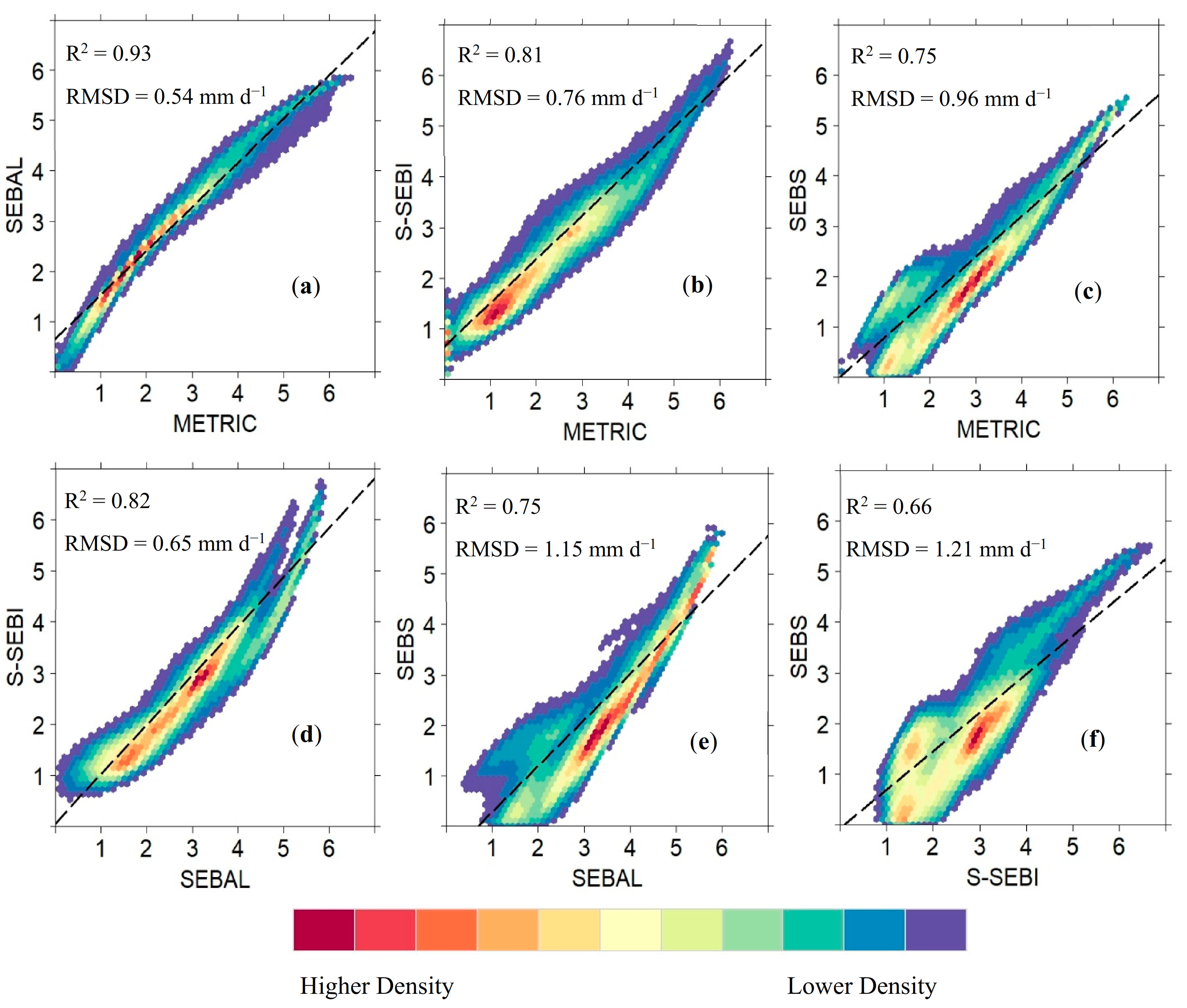

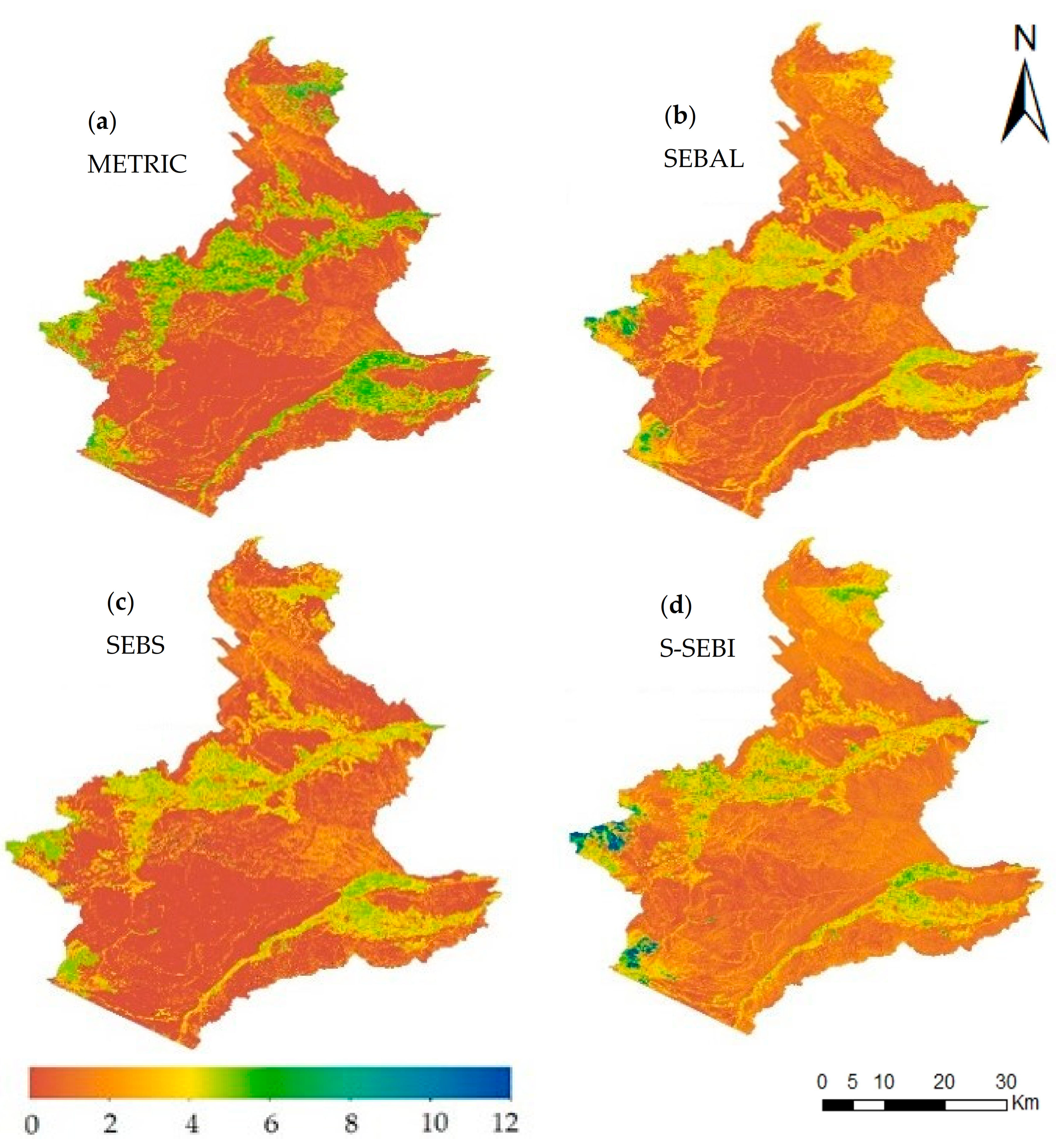
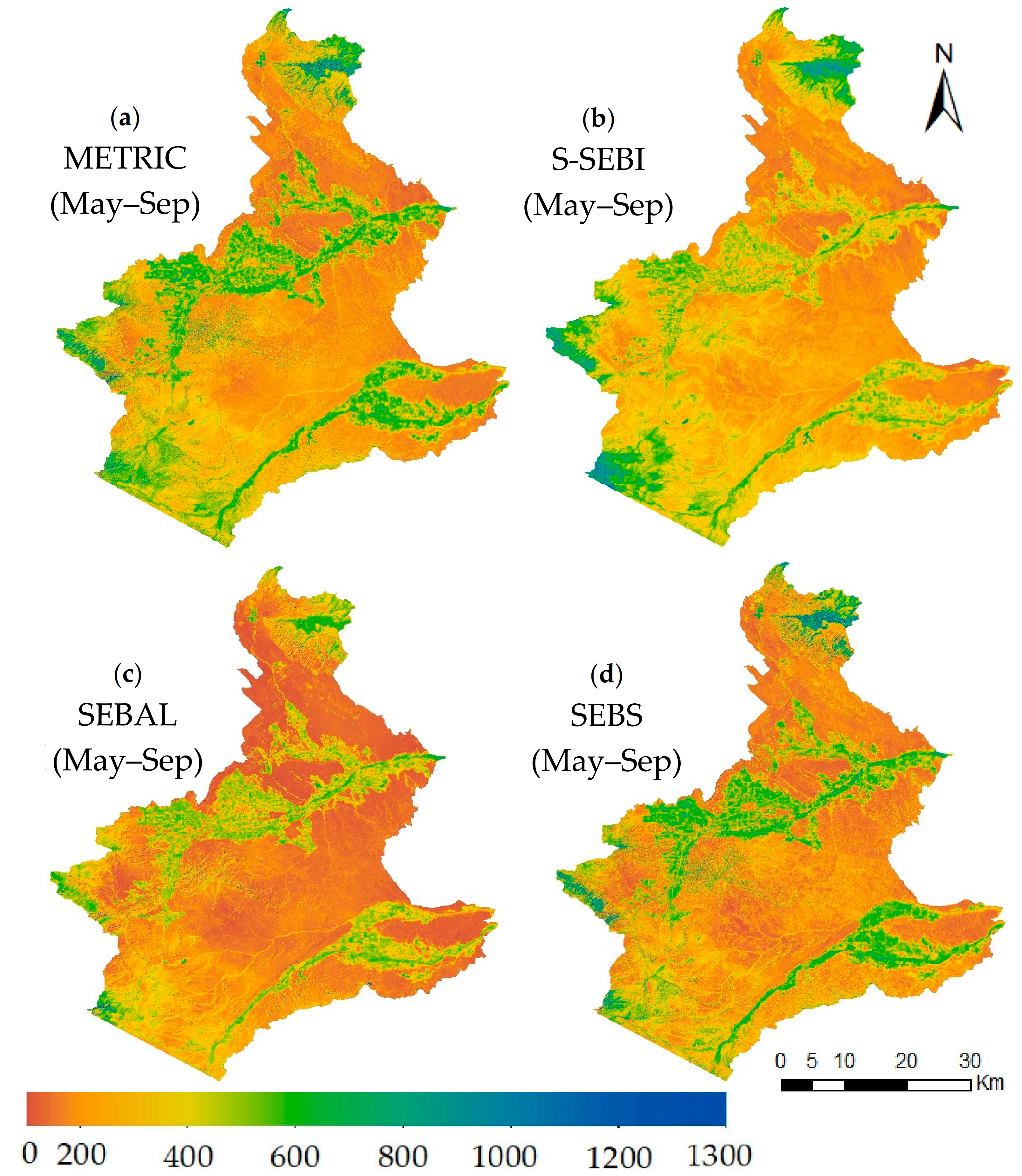
| Date | ID | Julian Date | Tmin (°C) | Tmax (°C) | RHmin (%) | RHmax (%) | u2 (ms−1) | Rs (W m−2) | P (mm) | ETr (mm d−1) |
|---|---|---|---|---|---|---|---|---|---|---|
| 15/7/2017 | L08 | 196 | 15.9 | 36.8 | 13.0 | 66.2 | 1.2 | 280.1 | 0 | 7.28 |
| 31/7/2017 | L08 | 212 | 10.8 | 33.3 | 12.4 | 84.3 | 0.9 | 306.0 | 0 | 6.3 |
| 16/8/2017 | L08 | 228 | 9.7 | 25.3 | 22.6 | 82.6 | 0.8 | 217.8 | 0 | 4.14 |
| 1/9/2017 | L08 | 244 | 15.0 | 31.4 | 17.6 | 68.4 | 1.2 | 178.3 | 0 | 5.15 |
| 9/9/2017 | L07 | 252 | 8.1 | 30.2 | 11.6 | 65.6 | 0.8 | 198.2 | 0 | 4.25 |
| 15/5/2018 | L08 | 135 | 6.2 | 19.9 | 33.8 | 100 | 1.4 | 235.9 | 0 | 4.33 |
| 8/6/2018 | L07 | 159 | 10.7 | 27.0 | 24.6 | 82.1 | 1.4 | 230.4 | 0 | 5.55 |
| 2/7/2018 | L08 | 183 | 10.4 | 27.8 | 16.2 | 81.7 | 0.8 | 300.0 | 0 | 5.55 |
| 18/7/2018 | L08 | 199 | 11.8 | 29.5 | 23.6 | 84.0 | 0.7 | 210.6 | 0.254 | 4.55 |
| 26/7/2018 | L07 | 207 | 14.6 | 28.8 | 26.8 | 69.6 | 1.5 | 262.7 | 0 | 6.36 |
| 11/8/2018 | L07 | 223 | 12.4 | 36.4 | 9.0 | 68.2 | 0.7 | 302.5 | 0 | 5.95 |
| 4/9/2018 | L08 | 247 | 6.8 | 30.7 | 11.6 | 77.8 | 1.3 | 261.8 | 0 | 6.03 |
| 12/9/2018 | L07 | 255 | 8.7 | 24.7 | 18.1 | 69.6 | 1.0 | 207.3 | 0 | 4.12 |
| 22/10/2018 | L08 | 295 | −0.2 | 21.6 | 16.8 | 74.0 | 0.9 | 151.5 | 0 | 2.49 |
| 3/6/2019 | L08 | 154 | 8.9 | 27.3 | 20.3 | 84.4 | 1.1 | 301.2 | 0 | 5.97 |
| 13/7/2019 | L07 | 194 | 13.3 | 33.4 | 20.8 | 82.5 | 0.9 | 300.5 | 0 | 6.26 |
| 21/7/2019 | L08 | 202 | 12.0 | 27.5 | 21.8 | 57 | 1.9 | 332.8 | 0 | 7.63 |
| 14/8/2019 | L07 | 226 | 9.5 | 28.3 | 19.4 | 77.8 | 1.2 | 298.5 | 0 | 6.01 |
| 15/9/2019 | L07 | 258 | 8.6 | 29.1 | 13.9 | 80.7 | 1.9 | 192.3 | 0 | 5.99 |
| Datasets | Models | Source/ Computation |
|---|---|---|
| Landsat 7- ETM+ and Landsat 8- OLI and TIRS | All | USGS (https://earthexplorer.usgs.gov/)(accessed on 6 March 2019) |
| Land use map | All | USDA National Agriculture statistical service (NASS) |
| Digital Elevation Model (DEM) | All | USDA Geospatial Data Gateway |
| Leaf Area Index (LAI) | All | Bastiaanssen [14] empirical equation |
| NDVI and SAVI | All | Using red and near-infrared bands (Huete et al. [45], Huete [46]) |
| Albedo (α) | METRIC and SEBS | Integrating the at-surface band reflectance using weighting coefficients (Starks et al. [47]; Tasumi et al. [48]; Olmedo et al. [49]) |
| SEBAL and S-SEBI | Morse et al. [50] | |
| Surface Temperature (Ts) | All | Modified Planks equation |
| Solar Incidence angle | All | Duffie and Beckman [51] |
| ETr | All | Wyoming Agricultural Climate Network (WACNet; Sharma et al. [42]) |
| MODEL | Year | Surface | N | R2 | Average | Average | SD | SD | PBE | RMSD | NSE |
|---|---|---|---|---|---|---|---|---|---|---|---|
| BREBS flux | MODEL flux | BREBS | MODEL | (mm h−1) | |||||||
| (mm h−1) | (mm h−1) | ||||||||||
| METRIC | 2017 | Sugar beet | 5 | 0.21 | 0.75 | 0.76 | 0.1 | 0.05 | 1.40% | 0.09 | 0.20 |
| 2018 | Dry Bean | 9 | 0.95 | 0.33 | 0.38 | 0.21 | 0.22 | 15.80% | 0.07 | 0.90 | |
| 2019 | Barley | 5 | 0.80 | 0.54 | 0.54 | 0.13 | 0.16 | 0.40% | 0.08 | 0.67 | |
| Pooled data points | 19 | 0.91 | 0.49 | 0.52 | 0.24 | 0.23 | 5.70% | 0.08 | 0.90 | ||
| SEBAL | 2017 | Sugar beet | 5 | 0.06 | 0.75 | 0.68 | 0.1 | 0.05 | −8.70% | 0.14 | −0.90 |
| 2018 | Dry Bean | 9 | 0.75 | 0.33 | 0.37 | 0.21 | 0.25 | 11.40% | 0.13 | 0.64 | |
| 2019 | Barley | 5 | 0.61 | 0.54 | 0.58 | 0.13 | 0.25 | 7.30% | 0.17 | −0.75 | |
| Pooled data points | 19 | 0.69 | 0.49 | 0.5 | 0.24 | 0.25 | 2.20% | 0.14 | 0.65 | ||
| SEBS | 2017 | Sugar beet | 5 | 0.71 | 0.75 | 0.69 | 0.1 | 0.04 | −7.50% | 0.09 | 0.19 |
| 2018 | Dry Bean | 9 | 0.90 | 0.33 | 0.45 | 0.21 | 0.18 | 38.30% | 0.14 | 0.53 | |
| 2019 | Barley | 5 | 0.80 | 0.54 | 0.6 | 0.13 | 0.13 | 11.10% | 0.09 | 0.57 | |
| Pooled data points | 19 | 0.87 | 0.49 | 0.55 | 0.24 | 0.18 | 12.30% | 0.11 | 0.76 | ||
| S-SEBI | 2017 | Sugar beet | 5 | 0.21 | 0.75 | 0.72 | 0.1 | 0.01 | −3.20% | 0.11 | −0.21 |
| 2018 | Dry Bean | 9 | 0.81 | 0.33 | 0.37 | 0.21 | 0.24 | 11.50% | 0.11 | 0.71 | |
| 2019 | Barley | 5 | 0.44 | 0.54 | 0.58 | 0.13 | 0.2 | 5.50% | 0.15 | −0.38 | |
| Pooled data points | 19 | 0.76 | 0.49 | 0.51 | 0.24 | 0.25 | 3.90% | 0.13 | 0.73 | ||
| Land Cover (% Area) | Model | May | Jun. | Jul. | Aug. | Sep. | Total | Land Cover (% Area) | Model | May | Jun. | Jul. | Aug. | Sep. | Total |
|---|---|---|---|---|---|---|---|---|---|---|---|---|---|---|---|
| Open Water (0.2%) | METRIC | 92 | 160 | 186 | 125 | 125 | 688 | Sod/grass seed (0.3%) | METRIC | 101 | 132 | 137 | 105 | 88 | 563 |
| S-SEBI | 128 | 176 | 170 | 115 | 97 | 685 | S-SEBI | 87 | 129 | 132 | 88 | 60 | 496 | ||
| SEBAL | 117 | 162 | 163 | 100 | 84 | 627 | SEBAL | 80 | 126 | 125 | 75 | 61 | 466 | ||
| SEBS | 89 | 122 | 136 | 101 | 153 | 601 | SEBS | 70 | 135 | 163 | 96 | 118 | 582 | ||
| Alfalfa (4.1%) | METRIC | 104 | 146 | 145 | 112 | 102 | 609 | Other hay/non alfalfa (1.4%) | METRIC | 98 | 136 | 126 | 89 | 83 | 533 |
| S-SEBI | 83 | 122 | 122 | 87 | 68 | 481 | S-SEBI | 79 | 119 | 112 | 72 | 60 | 443 | ||
| SEBAL | 85 | 131 | 129 | 80 | 70 | 494 | SEBAL | 75 | 125 | 109 | 59 | 57 | 426 | ||
| SEBS | 68 | 136 | 164 | 98 | 131 | 597 | SEBS | 59 | 128 | 147 | 76 | 114 | 525 | ||
| Sugar Beet (0.9%) | METRIC | 86 | 103 | 174 | 141 | 110 | 614 | Woody wetlands (1.3%) | METRIC | 93 | 146 | 157 | 107 | 91 | 594 |
| S-SEBI | 68 | 100 | 145 | 117 | 79 | 510 | S-SEBI | 90 | 140 | 139 | 87 | 70 | 526 | ||
| SEBAL | 70 | 103 | 155 | 107 | 77 | 511 | SEBAL | 79 | 141 | 145 | 75 | 71 | 511 | ||
| SEBS | 75 | 109 | 184 | 128 | 145 | 641 | SEBS | 72 | 147 | 178 | 96 | 126 | 619 | ||
| Dry Bean (0.8%) | METRIC | 73 | 89 | 124 | 123 | 62 | 471 | Herbaceous wetlands (0.3%) | METRIC | 87 | 123 | 127 | 88 | 84 | 508 |
| S-SEBI | 58 | 69 | 101 | 104 | 45 | 377 | S-SEBI | 77 | 117 | 117 | 73 | 65 | 450 | ||
| SEBAL | 57 | 69 | 105 | 91 | 44 | 366 | SEBAL | 64 | 120 | 119 | 60 | 68 | 430 | ||
| SEBS | 64 | 96 | 157 | 116 | 105 | 539 | SEBS | 45 | 112 | 143 | 69 | 110 | 479 | ||
| Maize (0.6%) | METRIC | 72 | 99 | 163 | 139 | 118 | 592 | Fallow/ Idle crop land (0.1%) | METRIC | 82 | 94 | 80 | 61 | 59 | 376 |
| S-SEBI | 56 | 85 | 129 | 109 | 80 | 459 | S-SEBI | 68 | 91 | 87 | 59 | 44 | 350 | ||
| SEBAL | 56 | 89 | 140 | 102 | 80 | 467 | SEBAL | 59 | 92 | 70 | 40 | 43 | 305 | ||
| SEBS | 61 | 103 | 181 | 125 | 149 | 619 | SEBS | 51 | 97 | 117 | 65 | 98 | 428 | ||
| Spring wheat (0.2%) | METRIC | 87 | 167 | 188 | 103 | 63 | 609 | Shrub land (49%) | METRIC | 71 | 76 | 45 | 16 | 27 | 235 |
| S-SEBI | 70 | 145 | 159 | 85 | 48 | 506 | S-SEBI | 72 | 88 | 75 | 37 | 39 | 311 | ||
| SEBAL | 68 | 148 | 162 | 75 | 46 | 499 | SEBAL | 40 | 68 | 43 | 17 | 49 | 217 | ||
| SEBS | 68 | 159 | 205 | 101 | 106 | 639 | SEBS | 28 | 62 | 74 | 19 | 69 | 252 | ||
| Barley (1.3%) | METRIC | 91 | 166 | 171 | 90 | 64 | 581 | Grass Land (11.4%) | METRIC | 76 | 70 | 33 | 16 | 22 | 217 |
| S-SEBI | 72 | 151 | 154 | 78 | 45 | 500 | S-SEBI | 64 | 70 | 56 | 34 | 31 | 255 | ||
| SEBAL | 72 | 152 | 158 | 65 | 46 | 494 | SEBAL | 38 | 46 | 18 | 13 | 38 | 153 | ||
| SEBS | 71 | 165 | 191 | 90 | 109 | 626 | SEBS | 33 | 55 | 64 | 20 | 64 | 236 | ||
| Oats (0.1%) | METRIC | 77 | 127 | 151 | 103 | 87 | 544 | Barren (0.8%) | METRIC | 71 | 55 | 17 | 12 | 18 | 172 |
| S-SEBI | 60 | 109 | 128 | 83 | 61 | 441 | S-SEBI | 68 | 64 | 51 | 35 | 29 | 246 | ||
| SEBAL | 59 | 116 | 131 | 75 | 63 | 443 | SEBAL | 49 | 49 | 12 | 37 | 59 | 206 | ||
| SEBS | 59 | 127 | 175 | 96 | 122 | 578 | SEBS | 37 | 48 | 54 | 20 | 60 | 219 |
Publisher’s Note: MDPI stays neutral with regard to jurisdictional claims in published maps and institutional affiliations. |
© 2021 by the authors. Licensee MDPI, Basel, Switzerland. This article is an open access article distributed under the terms and conditions of the Creative Commons Attribution (CC BY) license (https://creativecommons.org/licenses/by/4.0/).
Share and Cite
Acharya, B.; Sharma, V. Comparison of Satellite Driven Surface Energy Balance Models in Estimating Crop Evapotranspiration in Semi-Arid to Arid Inter-Mountain Region. Remote Sens. 2021, 13, 1822. https://doi.org/10.3390/rs13091822
Acharya B, Sharma V. Comparison of Satellite Driven Surface Energy Balance Models in Estimating Crop Evapotranspiration in Semi-Arid to Arid Inter-Mountain Region. Remote Sensing. 2021; 13(9):1822. https://doi.org/10.3390/rs13091822
Chicago/Turabian StyleAcharya, Bibek, and Vivek Sharma. 2021. "Comparison of Satellite Driven Surface Energy Balance Models in Estimating Crop Evapotranspiration in Semi-Arid to Arid Inter-Mountain Region" Remote Sensing 13, no. 9: 1822. https://doi.org/10.3390/rs13091822







